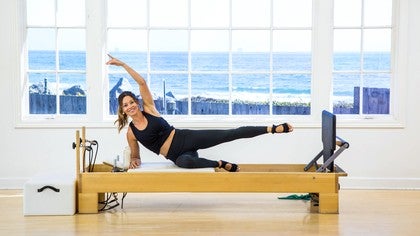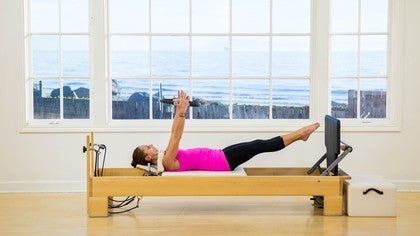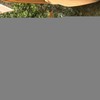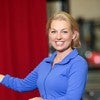Description
About This Video
Transcript
Read Full Transcript
Hi Guys, Courtney Miller here, back on police anytime with a jump board workout for you. Uh, we will not be jumping the whole time. Don't worry. And um, I really tried to build a class that worked the whole body. Um, I am using the resistance band throughout this class. If you have one, grab it. Uh, what I've done is I've just made a loop like this and I'm actually gonna put this around the shoulder blocks for later in a second. Such as going to sit there, I have what I would call springs to stabilize on. So the carriage just doesn't feel too wiggly under me. And I'm going to begin facing back taking the hands onto the rails that stretch before we begin to jump. So hands are on the rail, slightly forward of the shoulders. Curl those toes underneath you and then just press to a down dog, even a down dog ish position.
Now one thing that I like to do here is at walk my feet back so my heels can hang lower than the carriage. And that just gives me a big time stretch. And this is something that I like to do before I jump. And then after the jump board class as well, allow your upper body to feel free and there you have it. Lift your heels up, flex your spine and lengthen to a plank. Lower your thighs onto the shoulder blocks, and just give yourself an up stretch.
Think about pulling your chest through your arms. Take your toes down and press yourself back again and you might want to do that a couple of times, walking those heels, getting that length. If you have a long day or you been wearing a lot of stilettos, you might want to do an extra set or two and it's going to help you get that heel strike onto the jump forward as we go through class and just opening up that heart. Good. Press back, enjoy a nice little child's pose position. Change your springs. I want you to have a nice light spring on, so I'm on a yellow, which is a quarter spring and stand in the wow.
Before we begin to jump, I'd like to open up the hips a little bit. Walk your feet forward towards the back rail of the reformer and we're gonna use that band by hooking your back foot on it. And we're just going to do a standing lunch series. Feel free to use those risers as a balance aid just with light fingers. Inhale, bend into your front knee. Stretch.
Exhale, pull with the belly and with the hips. Inhale lunge and exhale pull. If you're feeling like you want to increase the level of here, then we'll add the upper body. So as you bend into the front knee, you'll pitch forward and exhale, pull even getting a little bit of a chest expansion sensation while you're last time like this and up. To increase the level of difficulty, you can hop your front foot onto a prop like a box. You want to start in a deep lunge position, body pitched forward, abdominals engaged.
Now the carriage is really pulling me backwards like this, so I have to drive my heel down and use that seat to stabilize. I'm going to pull the back leg in.
Mobilize the spine with five pikes. Think about tucking the chin towards the chest and rounding the spine versus just lifting the hips last time.
Inhale and exhale. So we're turning on the hip extensors, creating warmth and heat in the thighs and length through the hip flexors. Adding the upper body.
Come into a deep lunge. Hips are square, you're pitched forward. The back knee pulls
So we had a yellow. Now we have a blue coming down to a supine position, adjusting the headrest for you. You're not going to be down here very long and we're going to do what I would call core jumps. So this is more focused on the abdominals, not really working too much in that lower body region just yet. Move away from the shoulder blocks. If you're jammed in, have your toes towards the top of the jump board and take your arms out like a letter t.
I like starting in this position because it gives me that opportunity to open up through the packs. I draw the pinkies in towards my body as I curl up and then take the hands behind the head, push out to two straight legs, scan the body. So what I'm looking for is my inner thighs squeezing my quadriceps toned and engaged my toes in line and not staggered. Lift the heels up, lower the heels and just bend the knees a little. That's the biomechanics of what we're going to be doing. Sure.
It is a little jump. The emphasis is the ankle. The lower your feet land on the board, the more your core will be working. But stay honest. I'm bending my knees just a little sh so these aren't your moon jumps. Think of more the planter point and Doris.
I flex of the ankle. The knee just softens the landing five more.
Four, three, two, one,
Work on flexing and deep in the mat. See curves come up. Try to pull the tailbone underneath you as you go down and Ben to come in. Let's go with a little bit more flow. Press out and kick and kick and kick. Walk it up, walk it down, come in other side. Press out. One, two, three. Walk it up. Walk it down and come in. One more per side.
Three, two, one. Use the upper body to assist in both directions. Take it down last time, well one, and you'll notice the more you do the more that hamstring release's walk up. Walk down and bring it in. Nice job. Help yourself come up onto your elbows and forearms.
Now I like to use the shoulder blocks to help keep my humerus vertical. So I kind of dig my elbow back there and I think about the shoulder blocks. As a reminder, if I start to do that, stay lifted. Come into a c curve position where you shorten the distance from your hips to your ribs. Toes start towards the top of the board and exhale, jump. Now this is more like those moon jumps. So do you see how I get into a deep knee bend and I spring out?
I'm using my quadriceps and the muscles in my feet and ankles. Now this is an exercise of endurance, not just in the lower body but in the upper body as well. So if you find yourself slouching, bring your attention to those elbows, to the shoulder blocks. You'll notice I turned my palms up. You can play with palms up versus palms down.
Let's play with coordination. The legs wide to narrow. One of the great things about being up in this c curve position is that you can see the feet meet the jump board.
Deepen your scoop. Think about your single leg stretch exercise on the mat.
Right leg table top. We're going to play a little bit with internal rotation. I duction Ab duction so pay attention to that jumping leg. Let's jump in. Land towards the top of the board twice. So that's one and that's two.
Now jumping land to the left side of the board twice. Staying in parallel if you can. That's to jump and land low as low as you feel. You can keep your heel anchored and then cross the midline twice. Try that again. Top.
One more time. One wide or high I should say. Then wide, then low, then cross. Good job.
Take your top foot onto the job board and just push out to a straight leg for a moment. So I'm looking for your ability to keep those hips square. If you're having a hard time, then bring math forward a little bit. Okay, so hip bone over hipbone top hand will be onto the carrot, then the knee and jump. Now all of these jobs have been on a Baloo so far, so I am working through the quadriceps, but there's a big emphasis on ankle and foot mobilization here and strength. So bring your awareness to the foot. Think of the foot more like webbing and a dome versus something that's solid and flat. I had a lift.
When you jump
Now all you're doing here is getting this amazing posterior stretch. So draw the leg back, lifted higher without sitting in the shoulder. Allow that lat to stretch. Bring the foot forward so you can make your landing. And now that you know we're going to keep going. So three jumps, that's one stay lifted for those ribs. That's to look for the rise, right of your peripheral. Three lift and stretch.
That's one, that's two, that's three. And lengthen. One more time. Push two and three and lengthen. And you can feel how it's all connected from your toes all the way up through to your fingertips while you do that stretch. Come into four point kneeling before we do the other side. Let's do a headstand. When do you hear that in life? Let's just do a headstand.
Um, kind of. Okay, so I still have that blue spring on come down onto your elbows and forearms. Now this is a series that I introduced. It introduced in a work out a while back, I think it was 2016, um, plays any anytime and this is an adaptation onto that drop head down between hands. I have my elbows about shoulder with the part and I use the shoulder blocks here. I push down on my elbows so that my ears are away from my shoulders and I can see the jump board here. So I take a foot on and I push out.
I just work my foot up until I'm hooked on the top of the jump board. And then I take the other foot, the hips lift up, and I try to shift my weight over my shoulders. Okay, so that's what I'm trying to do here. Feel my butt over my shoulders and then inhale, lengthen out and I lift the hat up and come into a plank position. So tuck the chin, lift the hips, and even though the crown of my head is down, the weight is mostly in my elbows and it's my back helping to hold me out here and inhale, lengthen.
Next time we're going to add a single leg option. If you're happy just staying here and working your balance, then keep both feet on. I'm going to take a leg off and you may even take both legs off. I'm not going to yet. Maybe next time and Preso Tuck the chin, hips up, shifting the weight back over your shoulders and taking the leg down. One more time. Leg comes up. Shifting the weight
Lower one knee down and lower the other. Now before we do the whole series again on the other side, stay on your elbows and forms down here like this and knees are under the hips. Look back over a shoulder and push out to a straight leg. I can feel my heel and the top of the jump board. Bend the knee and press. Now, just like before, I want you to work. Getting that heel down.
It may mean that your knee bend is small. Now this is a lot of upper body right now. Shoulders are working to stabilize the shape, adding a leg lift, and as I kicked the leg up, drawing the belly
Actually I would call this more a lounge. Elbows down, ribs are lifted, bottom knees bent in top foot goes on the board in line with the hip, square the hips. So that means move the foot a little forward or a little back. Then adjust, push, not just with the quadriceps, with the hip extensors, with the ankle and the foot. Two more. And then we're going to add that little kick at trying to maintain that plank alignment in my torso.
So now we take the arm up overhead and notice that as you do, you get more of a lift and centrum underneath three jumps and then a catch. That's one, that's two and that's three. And just take this as an opportunity to create length and space. Bring the foot forward to land. Three jumps, so one,
Now we are going to do a second set of that headstand prep. Have you felt a little wobbly? You can always increase the tension a little bit. It doesn't have to be a Rad. You might just want to load the blue where you put the blue around the, the um, bolt versus the hook. So I did that. Okay, so here we go guys.
Coming back onto the elbows and forearms and I'll also show you another position too. If coming into a headstand prep is important to you, elbows or shoulder width, how does down that goes back and you can see it. So just take that foot to the top and take both feet. Now just to practicing, the sense of getting the hips up over the shoulders is perfect. You don't have to add anything fancy with the legs. I'm going to add a single leg lift and as the carriage presses out, how cross my ankles and lift the head.
So I just have a smaller base of support while I'm out here in my plank. Tuck the Chin and lift the leg. So squeeze and press. And the left.
And then this will allow you to kind of have a little base. You could put your knees onto your elbows and just practice your tripod. You can practice that sense of lifting your hips up over your shoulders like we worked earlier. You could go into your full a headstand here,
But do work to keep that heel on the board during the knee bend so you can use that whole foot and the plantar reflection of the ankle to get that Spring Adina
See if you can keep your legs steady as you rotate to the jump board and away. So I'm working dis association. I'm trying to rotate in my spine but not in my hips.
Push up to your downward facing dog like position. So you were here in the beginning of class. Step your stabilizing leg in line with the head rest and slide the strap leg out to the side on an exhale. This strap leg lifts up, so it's like three, like a dog position. And on an inhale, it sweeps wide to the rails. Exhale and inhale down and wide trying to keep your hips square ish when the leg comes up. And I'm definitely going into but have an arabesque. But what I'm trying to avoid is cinching my hip towards my shoulder or drooping in that side as the leg goes down. And I like to add a little knee bend here in my stabilizing leg when I go down.
And then it gives me a little bit more power and range.
I'm going to take the foot that has the strap in it, that leg and cross the knee behind. I would call this a curtsy position. Now I am trying to keep my hips behind my shoulders as I look towards the foot bar and open the leg and kick towards the jump board. Now my pelvis is rotated, but what I'm trying not to do is shift towards the shoulder blocks and inhale, bend, exhale, push and inhale, bend, exhale and curtsy. Three more. So sidekick and bring it in.
This is definitely whole body too.
So I like to begin in my best posture before going back into my seeker, taking the legs up, start rotated towards the police and see if you can work on this association. Moving the spine without moving the legs.
Send the legs away as you lower to your hundred and work to come back up. But try to stay straight. Inhale down, exhale up four more.
And before you go into a unilateral balance, just come on out for a sec. Okay, so that's the easiest way I find to get up. And you can get a nice calf stretch. Really. You're here. Take your stabilizing foot into the middle so it's in line with the head rest. And then your strap that goes to the side. The leg comes up on an exhale and down on an inhale, it has to go wider than the rails belly draws in and up.
And if adding that knee bend felt right to you, you bend the knee while the legs sweeps down and you straighten the leg
And I'm trying to keep my pelvis behind my shoulders. I crossed the knee behind. I would call this curtsy and then I'll look at the jump board. So I know the direction I want to send that foot and kick out to the side. Inhale, exhale.
So what I was mentioning is try to keep that stabilizing femur straight up and down. And that'll tell you that your hips are indeed staying behind your shoulders for more three, two and one
So I'm going to put a red. There's definitely days where I'll put a red and a blue. I'm feeling a little stronger, but it today's a red day. Um, you'll want your band wide. Okay? And if you prefer your head rest up while you John, which I think a lot of us do, then go ahead and adjust it. The band is going to cover the ball of the feet and the baby toes on both feet and you'll see why in a second. Your legs are, I ducked it and parallel.
Now you can hold onto that band with open grip. If you find it Slippy, then the easiest thing to do is to roll it over the knuckles. Okey-Dokey. The tail is coming through the thumb side. Here's why I love the band. As I press out and I maintain my bicep curl, my hip extensors have to work against the band, which is exactly what I want to try or tried to fire into when I'm jumping.
So no more soft knees. We really want to push, push through the foot, engage through the quadricep and fire into that whole back body.
If it's feeling a little sticky, we're going to add an arm reach. As the arms go up, the legs have to work harder to push down.
And one, you can also do this series with a single leg version. Now the fun thing about this is you don't only have to jump on the, but that doesn't have the band. So let's actually begin jumping on the foot that does have the band. You get that same feedback,
Adina, reach up with the arms down with the leg and you can absolutely go into exercises like your bicycle, which gives your brain and nice little challenge. Three more
Bang can go down, box can come on. We'll place the box on in short box position.
Um, but it's okay. You can just step to the side of the spring. The way to get in here guys is just push the box away first, creating an open space in the well, and then you can step your feet in and it's okay if the carriage touches you, nothing bad happens. Press your hips back against the jump board and feel a little bit of an anterior tilt to the pelvis and you'll see why in a second. Okay, so pressing the set bones back. Take one foot up, endorsee flection onto the box and push out to a straight leg. The reason I asked you to feel this anterior tilt is because as we straighten the leg, when we begin to stretch the hamstring, it's going to pull our pelvis into a posterior direction. So you're actually sort of countering the way that you know the muscle's going to pull by feeling belly of the muscle, lengthen tailbone back.
Then once you found that position, see if you can come to a balance. It's not easy. Then Dean and your box leg and pressing forward. I'm trying to stay vertical, so I'm trying to keep even weight onto my toes and heel on my standing leg.
You use the jump board to help you find your stability and then take your hands onto your hips as you go into your box presses. Inhale, when you bend and exhale. Again, it's the sense of vertical, so standing up, right
You have to take your hands on the box first so that the light can go back. And like I said, I like a little bend in my stabilizing leg so I feel more gluten. Mead, you could come up to Relevate, especially if you're more petite and feel free to rest that back leg.
What you're going to do is take the arch of one foot onto the front edge of the carrot and then take the other one out. I still have a blue. I'd like you to come to a standing position here so you do have some of your weight back on this board, but I can let go. Okay. Draw those legs together. Flex the spine, drawing ribs in and up. Now my preference for Tendon Stretch, oh by the way you're doing tendons stretch is to have the thumbs on the same side of the foot bar a at thumbs, at the same side as the fingers. I should say when I'm using the foot bar because I can wrap my fingers on this variation. I do tend to take my thumbs around. I want you to play with it and choose what feels best on your wrist.
Finding that c curve position, you'll press out using abdominal strength and length into a flat back. One tricep dip. And then hips come up as you come in. So if you hear that crashing in, then you need to stay to yourself. Less arms, more abs. That's what I'm saying to myself. I have to power less and breathe more.
All right guys, this is when you want to lay down. Put your feet in the straps. Do some circles. Pasha, maybe even a short spine or to, um, I'm gonna cut it here though. And this is a fun class, right? Yeah, it was jump board class, but we certainly weren't jumping the whole time. Have Fun with your inversions. Play with the resistance span and remember the why behind it. How it really helps you to get into that posterior chain and keep coming back to this class cause I guarantee you're going to see improved strength, endurance, and coordination. Thanks for joining me.
High Intensity Workouts - Playlist 5: Jump Board Workouts
Comments
You need to be a subscriber to post a comment.
Please Log In or Create an Account to start your free trial.








































